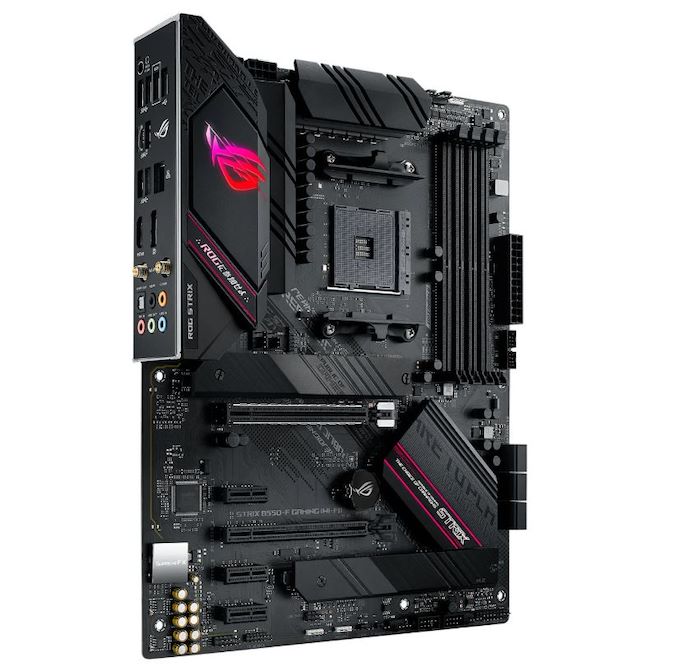The ASUS ROG Strix B550-F Gaming Wi-Fi Motherboard Review: Premium Value
by Gavin Bonshor on July 22, 2020 9:00 AM EST- Posted in
- Motherboards
- AMD
- Asus
- ROG
- AM4
- Strix
- Ryzen 3000
- Ryzen 3700X
- B550
- B550-F
ASUS ROG Strix B550-F Gaming Wi-Fi Conclusion
When AMD and motherboard vendors finally unveiled the B550 chipset, any potential conversational points were almost completely masked by discussions on the price. When a new B series chipset, that used to play in that $70-$200 region comes out *starting* at $165 and going beyond $300+, what else is there to talk about?? When delving deeper into the B550 product stack, as we did in our extensive B550 motherboard overview, it was clear that the majority of the models in the $200-300 price point are aimed at users that want or need premium audio and networking controllers. This is what ASUS has done with ROG Strix B550-F Gaming Wi-Fi, and it comes across as a polished example of a cost effective B550 motherboard,
Aimed at the mid-range, ASUS has equipped the Strix B550-F Gaming Wi-Fi with two M.2 slots, one with support for PCIe 4.0 x4 and one locked down to PCIe 3.0 x4. All of the boards PCIe 4.0 comes directly from the CPU, including the top full-length PCIe 4.0 x16 slot. The rest of the PCIe is driven by the B550 chipset which uses PCIe 3.0 lanes, including an additional full-length PCIe 3.0 x4 slot and three PCIe 3.0 x1 slots. One of the improvements over B450 is integrated support for USB 3.2 G2, in which ASUS has included two ports on the rear panel including a Type-C and Type-A.
Other interesting features include an Intel I225-V 2.5 GbE Ethernet controller and an Intel AX200 Wi-Fi 6 CNVi module which is generally found on more expensive X570 models; this is something which is becoming more mainstream in this price segment. It also includes a SupremeFX S1200A HD audio codec with a pair of amps which powers the onboard audio, and the codec itself does include EMI isolation which is a nice touch. The overall design is also interesting as it includes an all-black design with pink highlights on the rear panel cover and the chipset heatsink, which is very unconventional, but it blends in nicely and looks unique. Users looking to add more style can do so via three RGB headers, two regular and one addressable.
In our testing, the ASUS ROG Strix B550-F Gaming performed brilliantly in our system tests with the quickest POST time from any AM4 board we've tested with our Ryzen 3700X so far. The B550-F Gaming also had an impressive DPC latency result, with a massive advantage over other boards we've tested at default settings. In our CPU and game testing, the B550-F Gaming Wi-Fi was competitive. Our overclocking testing showed good results and tight VDroop control, with solid VRM thermals too. To put it mildly, the B550-F Gaming Wi-Fi has better VRM thermals than some X570 models costing double the price, which is a big win for ASUS here.

ASUS ROG Strix B550-F Gaming: Recommended
For $210 with Wi-Fi, or $190 without, ASUS provides a lot of quality and performance for the money. It puts to bed the expectation that B550 motherboards can't be as good quality as the X570 series models. Despite users expecting cheaper prices of B550, vendors look to have made improvements to the quality of the PCB to make sure the PCIe 4.0 implementation is optimal. There are lower cost B550 options available, but ASUS has a firecracker in the B550-F Gaming Wi-Fi and provides a solid alternative to X570.











40 Comments
View All Comments
shaddixboggs - Wednesday, July 22, 2020 - link
I won't give a dollar to ASUS for an AMD product. They've crapped the bed one too many times at this point.Alim345 - Wednesday, July 22, 2020 - link
Are higher benchmark scores of some boards are due to default bios configuration or beefier power delivery systems?deadstardragon - Wednesday, July 22, 2020 - link
Page 4 - Board Features - "For users looking to use compatible Ryzen APUs, there's an HDMI 2.1 and DisplayPort 1.2 output pairing"Correct me if I'm wrong, but I thought this MOBO had an onboard integrated graphics processor thus circumventing the need for a specific Ryzen APU. Given that, could you not use, say, a Ryzen 7 3700X like in your test setup and still take advantage of the onboard HDMI/DP?
mr0vka - Wednesday, July 22, 2020 - link
Has anyone read the article before posting? Are anandtech authors paid based on a numer of characters? This article contains multiple typos, and then (which is really irritating) multiple repetitions of the whole sentences across the article. In one place the only change in the whole paragraph that is being duplicated is “AMD” changed to “AM4”.WTH!?
supdawgwtfd - Thursday, July 23, 2020 - link
You must be new here...Has been an ongoing issue for years now.
It's to be expected when they have no editor.
PeachNCream - Thursday, July 23, 2020 - link
Anandtech has been dropping that ball for a good half decade or more. Part of the problem is article and table standardization through the use of prior articles and tables. That invariably results in mistakes when clearing old data before entering new information. Those sorts of errors show up constantly making it very clear there is lots of copy and paste sorts of slapdash happening behind the curtain. Professional writers and good editorial proofing are things you should look elsewhere to find.quantumshadow44 - Thursday, July 23, 2020 - link
pathetic. With msi x570 tomahawk msrp $210 this board has no chances.danjw - Sunday, August 2, 2020 - link
I think it would be better to list deltas from ambient in the VRM temperature chart. Since that is the real data, save users from having to do the math in their head. ;-)Also, I would really like to see Linux benchmarks added.
DiYBeast - Thursday, September 17, 2020 - link
Love it Asus rog makes the best top their boards